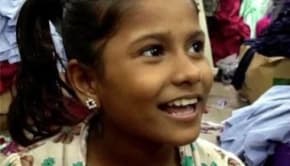
http://jobs.aol.com/articles/2013/10/14/sweatshop-child-labor-bangladesh/?ncid=webmail28
What's it like to work in a sweatshop? The underbelly of global labor is rarely exposed to the light of day, but one reporter for the Toronto Star successfully landed a gig over the summer working undercover trimming threads at a garment factory in Bangladesh for the purpose of documenting the experience. And very early in her tenure, Raveena Aulakh found out just how extreme such a workplace can be -- her manager was a 9-year old girl named Meem. Aulakh documented the experience in a series, entitled, "Clothes On Your Back."
Meem's official title is "sewing helper" in the factory. The report said the factory has no name, employs about 45 people, and is run by a man named Hamid. It's located in the Bangladeshi capital of Dhaka in an area "clogged with rickshaws, crowded buses and fancy cars," according to the Toronto Star report.
Factory life
The factory had poor to no windows or lighting, no fire extinguishers and a toilet that qualified as more of a hole than a passable restroom, according to the report. (The report didn't specify which retailers work with the factory, but the country's factories are known to serve western retailers.) Meem, for her part, ended up in the job as the result of a "fairly common story among poor Bangladeshi families: too many mouths to feed, too few bringing in money," according to Aulakh.
In Meem's case, her mother recently had to give up a job working as a domestic helper in a wealthy household when she found out she was pregnant. Other family demands forced Meem to seek out the job in Hamid's factory. Setting aside Meem's age, and the gig would have still run afoul of many countries' labor standards: the job offered no weekends, except for a half-day every Friday, no sick leave and no holidays. But in a country where roughly a third of the population is living in poverty, according to the World Bank, this was in fact a "prized job," even for a nine-year old, according to the report. It paid around $30 a week.
And Meem apparently only beamed positivity. During the reporter's four days on the job, Meem showed up early to her 12-hour days, which spanned from 9 am to 9 pm, so she could prep her threads. She maintained a sunny disposition, dancing jigs and humming Bengali songs. (She was yelled at for the latter.) And even at her tender young age finding herself in such a situation, she was still hopeful about her career path. "When I become a sewing operator, I will make very good shirts," she said. "No one will yell at me."
The child worker
Her story is shockingly common. According to statistics compiled by UNICEF, one out of six children in the world today is involved in child labour, "doing work that is damaging to his or her mental, physical and emotional development." Areas with high concentration of child labor are the Asia-Pacific region and Sub-Saharan Africa.
With their near-perfect eyesight, small fingers and little recourse for complaining about their working conditions, the system "works for everyone" as Smitha Zaheed, of the Dhaka-based Independent Garment Workers' Union Federation, told the Toronto Star. "Factory owners get workers who are not demanding . . . while the parents get to keep what the kids earn because the kids don't know any better."
But those hopeful for change may have reason to believe a better day lies ahead for workers like Meem. The Star's report was inspired by the this April at the Rana Plaza factory, at which 1,129 died. And the fallout has resulted in much more than a piece of investigative journalism. More than 100 retailers have signed agreements promising to pay millions to improve safety. And the garment workers have begun organizing for better rights. According to the Toronto Star, there are now 50 workers' unions for the country's 5,000 factories.